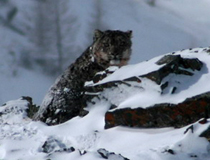 The participants in the first Russian-Mongolian expedition for the study of groupings of irbis (snow leopard), which took place from February 20 to March 7 on the Tsagan-Shibetu ridge (western Tuva), made the first photos of this rare predator in the republic, as announced by the World Wildlife Fund (WWF) of Russia. The participants in the first Russian-Mongolian expedition for the study of groupings of irbis (snow leopard), which took place from February 20 to March 7 on the Tsagan-Shibetu ridge (western Tuva), made the first photos of this rare predator in the republic, as announced by the World Wildlife Fund (WWF) of Russia.
During the field research the members of the expedition, which included specialists from the “Uvsu-Nur depression” nature reserve (Russia), from the administration of especially protected natural territories of the Ubsu-Nuur lake basin (Mongolia), and from the Institute of Biology of Mongolian Academy of Sciences, searched practically the entire Russian part of the Tsagan-Shibetu ridge, discovered 14 tracks of snow leopard and collected fecal specimens of irbis for clarification of their numbers by DNA analysis. The scientists successfully tracked some irbises and discovered areas of active range of the predators. The members of the expedition also discovered a family group of three irbises, apparently a female with two older kittens; they also were successful in photographing the animals for the first time in Tuva.
“In the future, it is planned to set up photo-traps in these locations, to study the spatial structure of the groupings of this species on Tsagan-Shibetu,” the report notes. After preliminary evaluation of these new data, the population of snow leopard on the Russian part of the ridge is estimated at 8-9 individuals. The scientists hope to get a more accurate picture of the numbers of sex-age composition of the population after DNA analysis of the predators’ fecal samples at the IPEE RAN laboratory.
As a result of DNA analysis of biomaterials collected on the Mongolian part of the ridge Tsagan-Shibetu in 2009, the numbers of the population of this species on this territory is estimated at 9 individuals. In this way, the total numbers of the trans-border population in this center of distribution is no fewer than 17-20 individuals. In April 2010, the work on the study of trans-border groupings of irbis on Tsagan-Shibetu will be continued on Mongolian territory. The obtained data will allow not just to estimate the condition of this group, but also to offer soundly-based suggestions for its protection. The development of eco-tourism in the irbis ranges based on reports by local people in Western Tuva with support of WWF should have a positive impact on the protection and development of the population of this predator. The action is planned to start already in May of this year.
The snow leopard, or irbis, lives in the mountainous heights of the Himalayas, Hindukush, Pamir, Tian-Shan, Altai and Western Sayans, Greater Caucasus and adjacent mountains. In the summer the animals prefer not to descent below the border where trees begin to grow, and live in the high rocky regions and mountain meadows, ascending all the way to six thousand meters. In winter the snow leopard find shelter in the forests located at the elevation of two thousand meters above sea level.
Illegal but lucrative hunting for snow leopard furs has substantially reduced the population. A snow leopard skin can bring in about sixty thousand dollars on the black markets of Asia. Snow leopard is under government protection in all the countries of its range, but poaching threatens its numbers just like before. Lately the number of the snow leopard has increased somewhat, and currently there are about six thousand individuals in existence.
|
